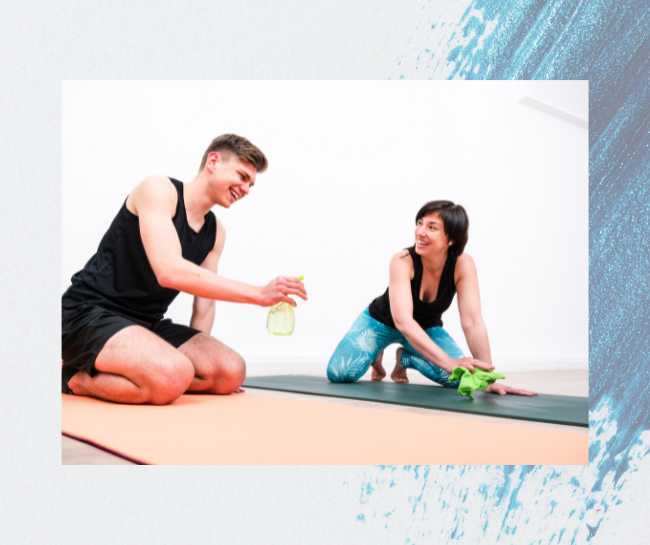
For yoga studio owners, understanding how to clean a yoga mat is more than just a routine task. It’s about merging aesthetics with hygiene, ensuring every participant feels welcomed and safe. A clean mat not only looks appealing but also guarantees that the practice space is free from harmful bacteria and germs. As we dive into this guide, we’ll explore the best methods to maintain the cleanliness and durability of your yoga mats, ensuring they remain fresh and inviting for every session.
Why Regular Cleaning is Crucial

Maintaining yoga mats isn’t just about appearance; it’s rooted in ensuring a healthy and enriching environment for practitioners. By prioritizing cleanliness, you’re setting a high standard for your studio.
Here’s why consistent cleaning of yoga mats is non-negotiable:
- Hygiene Benefits: Uncleaned mats can harbor bacteria, fungi, and other pathogens. Regular cleaning minimizes health risks and prevents skin infections or allergic reactions among users.
- Extending the Lifespan of the Mat: Dirt, sweat, and oils can degrade a mat over time. Cleaning helps retain its original texture and integrity, ensuring you get the best value for your money.
- Enhancing User Experience: Practitioners feel more comfortable and relaxed on a clean mat. The refreshing scent and feel enhance their concentration and connection to the practice.
💡 By keeping yoga mats clean, studio owners ensure a safer, more enjoyable, and more professional environment for everyone involved.
What is the Best Way to Clean a Yoga Mat?

Choosing the right cleaning method for your yoga mat isn’t just about hygiene; it also affects the mat’s lifespan and overall user experience. As studio owners, understanding the nuances of proper care can elevate the studio’s reputation and ensure consistent client satisfaction.
- Daily Quick Cleans: After each session, use a soft cloth and a gentle cleanser to wipe off sweat and oils. This routine prevents the build-up of grime and keeps the mat fresh for the next user.
- Weekly Deep Cleans: At least once a week, submerge the mat in lukewarm water mixed with mild detergent. Scrub gently using a soft brush, rinse, and let it air dry. This deep cleanse gets rid of embedded dirt and gives the mat a rejuvenated feel.
- Products and Solutions Recommended: Opt for specialized yoga mat sprays or cleansers available in the market. They’re formulated to be gentle on the mat material while effectively disinfecting it. Avoid using harsh chemicals, as they can damage the mat’s texture and integrity.
💡 Implementing a structured cleaning regimen not only safeguards practitioners but also instills a sense of dedication and professionalism in the studio’s operations.
Can I Clorox Wipe my Yoga Mat?

While Clorox wipes are effective at disinfection, they might be too harsh for yoga mats, leading to wear and tear. It’s advisable to use gentler alternatives designed for mat cleaning.
Storage and Maintenance Tips

Correct storage and maintenance of yoga mats are vital, equal in importance to cleaning. Proper care not only prolongs the mat’s life but also safeguards its quality. A studio’s attention to these details enhances its reputation, as it showcases a commitment to client comfort and safety. Here’s how to achieve this:
- Proper Drying Techniques: After cleaning, always allow your mats to dry thoroughly before rolling them up. Hanging them horizontally in a shaded area or using specialized mat drying racks can speed up the drying while ensuring no moisture gets trapped, which could lead to mold or mildew.
- Roll, Don’t Fold: Rolling your yoga mat instead of folding helps to prevent creases and maintains its structural integrity. Ensure that the side used for exercises faces outward when rolled to minimize wear and tear.
- Storage Racks or Bags: Investing in dedicated storage racks or bags can be beneficial. It keeps mats from touching the floor and provides ventilation, thus reducing chances of bacterial growth. Bags also offer the added advantage of portability.
- Avoid Direct Sunlight: Prolonged exposure to sunlight can degrade the material of yoga mats and fade their colors. Always store them in shaded areas.
- Maintain Temperature and Humidity: Yoga mats can warp or become brittle when stored in extreme conditions. A controlled environment, away from direct heat sources or excessively damp areas, is ideal.
By integrating these maintenance tips into your studio’s routine, you not only enhance the life of the yoga mats but also convey a message of professionalism and care to your clientele.
Yoga is all about mindfulness and harmony, and that should extend to our equipment. Clean mats not only provide a better experience but also demonstrate care and professionalism. By observing these tips, studio owners can ensure their mats remain pristine and inviting.
Ready to take your yoga studio to new heights? 🧘♂️ Dive into “Opening a Yoga Studio: A Comprehensive Guide for New Owners” and unlock the secrets to success. Plus, supercharge your studio management with Spark, the ultimate all-in-one solution.